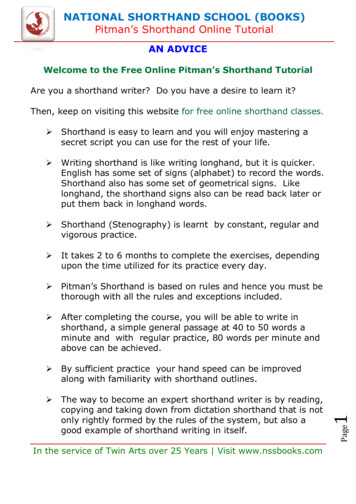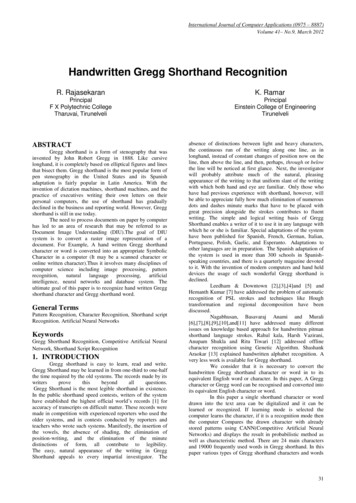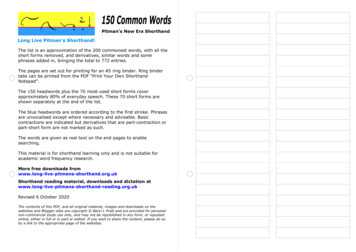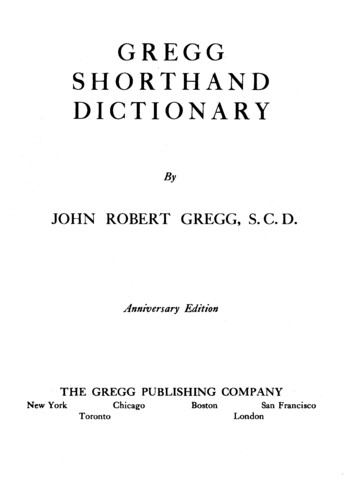
Transcription
Shorthand pdf books download pdf free software for windows
Court reporters have used stenography for over a century to write at over 200 words per minute, faster than most people speak. Ergonomic Stenographers stroke chords instead of typing keys, resulting in less movement and better ergonomics than typing. Flexible Steno chords can map to words, phrases, symbols, emoji, macros, and more. GreggShorthand is a form of shorthand that was invented by John Robert Gregg in 1888. Like cursive longhand, it is completely based on elliptical figures and lines that bisect them. Gregg shorthand is the most popular form of pen stenography in the United States; its Spanish adaptation is fairly popular in Latin America. With the invention of dictationmachines, shorthand machines, and the practice of executives writing their own letters on their personal computers, the use of shorthand has gradually declined in the business and reporting world. However, Gregg shorthand is still in use today. Gregg Shorthand was first published in 1888 by John Robert Gregg; however, it was in a very primalstage, and therefore did not gain much success. Five years later, a much better version was published. This version was published in a second edition in 1893, then in a third edition titled "Gregg Shorthand" in 1897. The fourth edition, published in 1902, developed more shortcuts. The fifth edition, published in 1916, is the version most commonlyreferred to as "Pre-Anniversary" Gregg shorthand; this version has the largest number of brief forms, phrases, and shortcuts. Click to viewAt every turn on the internet, someone's offering a free software download for your PC. But separating the wheat from the evilware-addled chaff isn't for busy users with better things to do than test applications allday long. That's where we come in.Today we've got our top picks of free Windows software downloads that will make your PC faster, stronger, more functional and productive. This list was tough to whittle down from a huge field of candidate applications, but that means our 10 choices are that much stronger.Read on for 10 great free Windowsdownloads sure to make your PC experience that much better.Lifehacker photo galleries require Javascript; if you're viewing this in an RSS reader, click through to view in your Javascript-enabled web browser. Now, we wanted to list almost as many apps on this list as an honorable mention, but I'll leave that up for discussion. What would your topfree Windows download list looked like? Let us know in the comments. If you’ve downloaded a file using Chrome, Edge, or Firefox on Windows 10 or 11, You can usually find it in a special folder called “Downloads.” Even if you saved the file somewhere else, we’ll give you some tips on where to look. How to Find Your Downloads Folder Windows 10and 11 both include a special folder called “Downloads” that is unique to each user account on the PC. By default, it’s located in your user folder with the path C:\Users\[User Name]\Downloads , where “[User Name]” is your Windows user account name. You can find your Downloads folder easily using File Explorer in Windows 10 or 11. First, openFile Explorer and click “This PC” in the sidebar. Then either click “Downloads” in the sidebar or double click the “Downloads” folder in the main File Explorer window area. Once you open it, you’ll see all the files you’ve saved to the “Downloads” folder. By default, all major web browsers save files to this location, but it’s possible to save filessomewhere else. If that’s the case, you can find clues about a downloaded file’s location in your web browser itself, which we’ll cover below. RELATED: How to Open File Explorer on Windows 11 How to Find Downloads Not in the Downloads Folder Since it’s possible to download files to a location other than the default “Downloads” folder, you mighthave downloaded a file once and lost it. In that case, you can check your favorite browser’s download history to see if it’s listed there. If you’re using Edge, Firefox, or Chrome, press Ctrl J on your keyboard to open a list or tab that shows your download history. Or you can open a browser window and click the menu button in the upper-right corner ofthe window. In Firefox, the menu button looks like three lines. In Edge and Chrome, the button looks like three dots. Once the menu appears, click “Downloads.” In Edge, a small “Downloads” list will appear. In Firefox and Chrome, a “Downloads” tab will open. To see a downloaded file’s location in Edge, locate the file in the list and click the foldericon beside it. To see a downloaded file’s location in Firefox or Chrome, locate the file in Downloads tab and click the “Show in Folder” link below it. After clicking the link, a File Explorer window will open showing the location of the file you downloaded. Note that this method won’t work if you’ve moved the file after you downloaded it, but manytimes, it will point the way exactly. If you still can’t find the file you downloaded, you can try searching for the file using Windows itself. Good luck! RELATED: How to Search Quickly on Windows 11 Now a days Short Hand Language & typing is very important for private & Government Jobs. Shorthand is an abbreviated symbolic writing method thatincreases speed and brevity of writing as compared to longhand, a more common method of writing a language. The process of writing in shorthand is called stenography, from the Greek stenos. ***App Feature*** * Learn Short Hand & Stenography Fast. * English Guide For Steno & Shorthand. * New Offline Shorthand Guide Book. * Best Book fordummies & Beginners. * Learn Shorthand Alphabets, writing, Vowels, words. * Easiest Way to Learn Short Hand. * Ford Improve Shorthand. Virtual Flange Slide Rule Valveworks USA · Books & Reference Riyaadu Saalixiin Abdirsaaq Macalin · Books & Reference Tadreeb us sarf urdu sharah for ilm us sarf Rabia Basheer · Books & ReferenceQur'ondan Kichik Suralar Androazeri (Nural İsmayilov) · Books & Reference Free Big Magic Serials-Hotstar HD Tips 2021 ASMA MANPOWER · Books & Reference RCZ Hymns - Nziyo dze Kereke Diggle E Gonese · Books & Reference Bíblia Linguagem Atual summtech · Books & Reference Togel INDEK 2020 Checkup Dev · Books & Reference OneWord Substitution Offline Dictionary VD · Books & Reference J.B. Phillips New Testament Bible - Offline! Christian Bibles Developers: Daily Inspirations. · Books & Reference PITMAN ENGLISH SHORTHAND Strokes with attachments Wel, Hwel and Hway are the only instances of a hook adding a sound BEFORE that of the main stroke, all otherhooks add a sound after. It helps to think of the strokes below that have such permanent "attachments" as complete strokes in their own right, otherwise confusion may result when learning the R, L, F/V and N hooks. The reason they have attachments is that, as the system developed in its early days, more strokes were required than were availablefrom the straight lines at various angles and segments of a circle. Therefore various unused combinations were made use of, e.g. Ray was given initial hooks to make Way and Yay, which were originally shown by the small semi-circle and the downstrokes that we now use for Rer and Ler; the combination S-CHR, not occurring in English, was usedinstead for downward Hay, the H sound originally being represented by only the aspirate dot and the upstroke that is now used for Yay. Stroke Name Direction Angle from Notes Vertical Sound also represented by Pee Down 45 Emp-Emb thickening of Em Bee Down 45 Emp-Emb thickening of Em Tee Down 0 Halving; doubling for "-ture" Dee Down0 Halving Chay Down 30 Jay Down 30 Kay Horizontal 0 Part of the con/com dot Large initial hook for Kway Gay Horizontal 0 Large initial hook for Gway Hay Down 30 Down version for better joins and can be reduced to a downward tick before some strokes Aspirate dot Hay Up 60 Upward Hay is most frequently Aspirate dot used Way Up 60 The Way vowel sign, Sway circle Large initial hook for Hway Yay Up 60 Sometimes U diphthong within a word Hay, Way, Whay, Yay: Use 30% angle if a full downstroke follows, in order to keep the base of the 2nd stroke level with it Ell Up 45 Sometimes down for better joinings. Sometimes choice is made for vowel indication. Small initial hookInitial hook on upward Ell makes Wel Large initial hook on upward Ell makes Hwel Downward Ell thicken for Ler Downward Ell halve and thicken for Ld Ar Down 45 Vowel before it; exceptions Final part of doubling apply to obtain better joinings. Thicken for Rer Halve and thicken for Rd Ray Up 60 No vowel before it; exceptions Initial hook applyto obtain better joinings. Use 30% angle if a full downstroke follows, in order to keep the base of the 2nd stroke level with it Ef Down 45 Final hook Vee Down 45 Final hook Ith Down 0 Thee Down 0 Doubling for "-ther" Ess Down 0 Circle S, SES and Sway Zee Down 0 Circle S, SES Ish Down 45 Sometimes upwards for better Part of the Shunhook joinings. Sher is always downwards Shel is always upwards Zhee Down Em 45 Always down – no thick stroke Part of the Shun hook ever goes up. This is the sound in "measure" Horizontal 90 Thicken for Imp or Imb Halve and thicken for Md En Horizontal 90 Final hook. Initial hook for "instr" Halve and thicken for Nd Ing Horizontal 90 Thisis a single sound. Derivative words may retain separate En and Gay, where the resemblance to "ing" is coincidental. The "ing" dot and the "ings" dash Top of page QUICK REFERENCE TABLE Name & Place Examples Additional vowel SHORT VOWEL Mnemonic Vowel plus one diphone 1 THAT bat sahib 2 PEN bet 3 IS bit 1 NOT tock 2 MUCH tuck3 GOOD took LONG VOWEL 1 PA pa baa-ing 2 MAY pay payer 3 WE pea previous 1 ALL saw sawing 2 GO so sower 3 TOO sue DIPHTHONG bluer Diphthong plus one triphone 1 I by buyer 1 ENJOY boy loyal 3 LOUD out power 3 MUSIC few fewer Top of page SHORT AND LONG VOWELS Short vowels light dot or dash Mnemonic: THAT PEN ISNOT MUCH GOOD Long vowels heavy dot or dash Mnemonic: PA MAY WE ALL GO TOO The mnemonics contain short forms so those particular outlines cannot be used to illustrate all the vowels, but the simplicity of the sentences has served generations of shorthanders very well over the years and they are worth preserving as our "shorthandheritage". The dashes are written at 90 to straight strokes, therefore they change their angle as the stroke changes its angle. The dash is generally written from the stroke outwards and about a quarter of the length of a normal stroke; a dash should not be written straight up or straight backwards, in order to maintain smooth writing and avoidingcatching the nib against the paper. Against horizontal strokes the dash is always written downwards. For curved strokes, the angle of 90 changes along the length of the stroke. The angle of a dash vowel is therefore not meaningful when used in an outline, but is only meaningful when used alone as a short form – See Short Forms List 4 page Shortforms from vowel marks: toe gnaw know noose maw mow moon bought Some dash vowels end up being written with an upward slant and this is the only time that any thick mark is written upwards, as in the outline "bought" above. The angle of the dash may be adjusted slightly in places where there is limited room between strokes: droll dhurrieroach Heavy dots and dashes must be written with one stroke of the pen, not moved around on to thicken them up. Students of phonetics will notice that in Queen's English "pay" "sew" and similar words are not simple vowels but diphthongs, despite all the shorthand books describing them otherwise. They and the diphthongs below are, however,single phonemes (meaningful units of sound) in English, and generally found within one syllable, which is why they are perceived as one sound. I suspect that such words are pronounced with simple vowels in English accents other than the present Queen's English standard. This is borne out by a teachers' textbook that I have which advises south ofEngland teachers to place extra emphasis on the "pure long vowel" of "lake", which to southern English ears does sound more like an accent from further north of the country. Top of page DIPHTHONGS (pronounced dif-thong **note** ) Two vowels sounded in quick succession, glided together and producing one syllable. Mnemonic: I ENJOY LOUDMUSICThere are 4 diphthong signs - two first place, two third place. There are no second place diphthong signs. No heavy versions. The first three never change angle, the last may be rotated when joined. First place pie tie china lie rye my nice fine vie thigh sigh shy sky wise high I/eye Joined at the beginning of some downstrokes and in phrases:ice eyes idea item Ivan ire, I have, I think, I say, I shall For convenience, joined finally to stroke En (despite being a first place vowel) when no other stroke or ending follows: night nigh deny downright fortnight finite Anno Domini but nights denies Contracted to a tick on upward Ell: isle/aisle island islander Eileen/Aileen (but Aileen if so pronounced)As short form for "I", contracted in phrases where convenient: I believe, I propose, I regret, I can, I am, I will have First place The top half of the sign is written horizontally: poise toy joy coy coil moist noise foible voice hoist Joined only to upward Ell. The angle is adjusted slightly but this does not clash with the third place vowel "owl" because of theoutline's position. Not joined to other strokes because not convenient and could be confused with "of the": oil oiled oil-field oil-tanker oil-well Third place out ouch joust cow mouth noun found shout loud how (short form) Joined initially to upward Ell, despite being a third place vowel, for convenience: owl owlet owlish owl-like Joined as short form inphrases: how many, how long Joined finally where convenient: bow prow pout brow browed dhow/Dow doubt vow thou sow Howe Contracted after stroke N, when nothing else follows in the outline: now Lucknow but nous Third place puma tune tuna tube cube suitable fume music Hume you (short form) (the surname "Hume" is sometimespronounced "home") Joined finally where convenient, when nothing else follows in the outline. Rotated when joined finally to horizontal strokes or upward ell. Do not rotate when free-standing, because this clashes with the W series of signs: few pew cue/queue/Kew due/dew mew new continue pursue value As short form, joined where convenient:thank you, if you will, for you are, you should, can you, may you Top of page DIPHONES A simple vowel followed immediately by another separately sounded vowel, thus forming 2 syllables.Written in the correct place of the first vowel of the pair Angle never changes Never joined No heavy versions Arrowhead, at 45 angle pointing south west, isused for a dot vowel plus any other: sayer layer weighing previous readmit create neon tiara Maria Arrowhead, at 45 angle pointing north east, is used for a dash vowel plus any other: sower snowy stoic poem gooey bluey jawing gnawing rawish Diphones are often encountered as extensions to an original simple vowel, and so the vowels areperceived as two separate phonemes (meaningful units of sound): pay payer mow mowing mower high higher but hire Also used for these types of endings, although the vowels are barely sounded separately: righteous question suggestion combustion pinion onion bunion but Bunyan trachea* tracheae* Separate dots are used for the plural todistinguish the outlines - the extra dot cannot be mistaken for Dot Hay, because Dot Hay is never used finally. *pronounced track-ee-uh and track-ee-ee Diphones are not used for: (a) short forms that have stroke Ing added, because short forms are not vocalised, and the Ing needs only its own dot: be being go going do doing (b) when adding "dot ing"because the dot represents the whole "ing" extension: paying toying trying but tryingly Top of page TRIPHONES Three vowels sounded in succession, normally a diphthong plus one other, producing two syllables. Shown by extending the diphthong sign with a tick. Written in the correct position of the first vowel of the pair Only joined finally Noheavy versions diary dial briar trier diameter flyer denying ionise loyal royal joyous soya boyish moiety annoyance sequoia power tower flower/flour towel vowel viewer duet continuous puerile steward skua skewer but secure Some triphones consist of a simple vowel followed by a diphthong: write the diphthong next to the vowel (note the light dot isused): radii genii denarii nuclei As with "tracheae" above, the dot cannot be mistaken for Dot Hay, because Dot Hay is never used finally Top of page VOWEL PLACEMENT 1. A vowel sign is placed to the side of the stroke, at the beginning, middle or end. The vowels are therefore described as first, second and third place vowels. All the strokes of theoutline or phrase must be completed before any unjoined vowel is written. The beginning of a stroke is counted from where the pen starts writing it. With strokes that can be written in either direction, the vowel placement will vary, and care should be taken when the stroke stands alone, both in writing and in transcription. Vowel before: place to leftof up or downstrokes, upper side of horizontal strokes Vowel after: place to right of up or downstrokes, lower side of horizontal strokes ape pay, Abe bay, aid day, age jay, ache Kay aim may, inn no, ingle swinger if fee, Eve vie, either thought, thin us so, owes zoo, ash show ale low, air row, awake way, ayah yes, ahem high 2. Place outside of circle S,Sway, Stee and Ster loop: bees beast swan star stock stopper poster blister 3. SES circle is deemed to include the vowel in "pen"; if it is a different vowel, write it inside the circle: success masses bases (plural of base), basis, bases (pronounced baseez, plural of basis) emphasise emphasis exercise Dash vowel inside the circle – Books vary in showingat what angle it is written: census Colossus exhaust 4. Shun hook – vocalise the stroke just as you would if the shun hook were not there, with the following exceptions: (a) Third place dots written inside the shun hook: fashion fission vision revision mission permission lesion In most cases the dot inside the hook is the vowel immediately before theShun, but sometimes it is the vowel before that: remission television compare initiation (b) Third place dashes, diphones and diphthongs are written outside the shun hook when the hook is final (because they need more room) and inside when the hook is medial (to avoid the sign being read as belonging to the next stroke). fusion solution ammunitionrevolution revolutionary education educational radiation mediation pronunciation renunciation deviation deviationist The vowel between the Sh and N of the "shun" is not vocalised at all, and the fact of the vowel being written inside or outside the hook is coincidental to getting the dot or dash or other sign against its own stroke, i.e. it is not part ofthe "shun" syllable. Circle S Small shun hook – the hook is deemed to include the vowel in "much" and requires no vocalisation itself. The vowel that comes between circle S and the small shun hook:Dash vowel: never occurs First place dot: never occurs Second place dot: omit Third place dot: write outside the hook (underlined below) possessionposition precision decision condensation physician incision sensation musician recession recision In these examples underlined above, the vowel sign is actually being written against the little hook and not against the stroke, i.e. it is sounded after the S and before hook, and not sounded before the stroke. A third place vowel before the stroke shouldbe placed a little way inwards from the hook. The following illustrates two vowels on the hook side of stroke: apposition opposition imposition 5. Ell is normally an upstroke, therefore: ell ill ale eel isle oil owl* Eli Leah *In "owl" the third place vowel is joined to the beginning of the stroke for convenience, the only word that does this. When Ell iswritten downwards, the vowels follow suit: like alike 6. Ish is normally a downstroke, therefore: ash shy shah shot show shut she shoe/shoo shoot/chute sheet shout When Ish is written upwards the vowels follow suit: shaggy shagreen/chagrin, shack shackle, sham shammer 7. After a halved stroke, the vowel should be written against the secondstroke, as it is sounded after the T or D: cottage pottage bandage octopus potato written 8. All dots and dashes should be just far enough away to be distinguishable as separate marks, so that they do not interfere with the recognition of the strokes themselves. Only these instances have a dash vowel joined: awl also; the short form "all" may also bejoined as in: almost already Top of page INTERVENING VOWELS Intervening means "coming between" (A) coming between two strokes 1st and 2nd place vowels: place against the preceding stroke: pod paid bat boat dock duck tag take jag jug mock make notch nape shadow shed lock lake rag rug wad wed yak yoke hack hake hang hung 3rd placevowel: place before the following stroke. This is because a third place vowel written after the first stroke could end up in an angle between strokes and therefore be ambiguous – you would not know whether it was a third place vowel after the first stroke, or a first place vowel against the next stroke: peel pull big beet book tick took deep jig cheap figfood video meal nil pip peep bib beep cook gig If the two strokes are separated by a circle S or S-plus-hook, then the vowel must remain with the first stroke, it cannot "jump" over the S, because it is sounded before. The presence of the S or S-plus-hook enables the vowel to be written in its correct third place with less ambiguity: Dick disk, leap lisp,creep crisp, ping pinning A compound word is one that is made up of two other words. In the outline for a compound word, the vowel often remains where it would be if the words were written separately, thus aiding legibility: headache book-end steam-engine Compound words are treated as one outline as regards to position (unlike phrases wherethe first word is written in position and the others tag along). Therefore the first up or down stroke might reside in the second of the two words, such as "steam-engine" above. The above does not apply to derivative words, where there is one word and one affix; these have the vowels placed normally according to the basic rules: unable inorganicinactive fewness steamer (B) coming between an initial hook and the stroke (e.g. PR and PL) See also Theory 7 Hooks R L/Vocalisation and Theory 15 R Forms page/R Hook For Brevity for more examples. Although the R and L hooks are primarily used to represent the two consonants together, sometimes the hooked form is used even though a vowelis present, in order to avoid an awkward outline or obtain a better outline for very common words. Most of such intervening vowels are only lightly or indistinctly sounded. If the vowel is "-er" as in "permit" it is not shown. It is however taken to be a second place light dot vowel (and is in fact shown as such in other outlines that are not using a hook)and so the outline takes second position, where this is the first vowel. permit perfect persist term germ therm Other vowels between the stroke and hook are indicated as follows: A dot vowel is written as a disjoined circle, in its correct place, after the stroke unless that place is occupied by another vowel or there is no room to write the vowel.challenge sharp carbon philosophy varnish flashily atmosphere Note: Very many "car consonant" words use the R hook A dash vowel is written across the beginning of the stroke, through the centre or through the end; it is not written across the end because that would look like the "ings" suffix. Where a second place dash vowel is written throughthe stroke, the following vowel has to be written against the next stroke, as in "courage" and "occurrence" below: tolerable correspondence church George shovelful fulfil courage occurrence A diphone or diphthong may also be written through, or at the end of, a hooked stroke: healthier junior direct (2 pronunciations) temperature mixture capturecaptures capturing The above use of R or L hook plus intervening vowel is not generally used for words of one syllable: pale pair tall tore jeer mare Some short words use the intervening vowel to gain a brief outline, where clashes are unlikely: nurse dark gnarl barm course Turk NOTE: The prefixes "self-" and "self-con-" also use a circle (in this caserepresenting the S sound), and the outline is always in second position to match the vowel in "self". "Self-" circle is written before the stroke in second position. It might therefore look identical to a 2nd position intervening vowel, but the rules state that the short E vowel between stroke and hook is not shown (whether accented or not), although allother vowels may be shown. Therefore no clash occurs. self-defence self-employed, Jersey shelf (2nd position vowel not written) "Self-con-" circle is written against the top end of the stroke, replacing the "con-" dot, so this cannot be mistaken for an intervening vowel, which is always against the side of a stroke. self-confidence self-control "self-" and"self-con-" must always be written, unlike the vowels which are only written when needed (see Theory 18 Prefixes page). POSITION WRITING Position writing is a great strength of the system, enabling vowels to be indicated without any extra writing. Position writing combined with the various choices of abbreviating methods combine to make itclear which word is signified, without guesswork, when the vowels are eventually omitted. Unlike omitting vowels, position writing is not optional and you should practise inserting vowels until you know their placement perfectly, for two reasons: you need to know what and where they go in order to write the outline in the correct position, and whenyou do need to insert them, you have to do it very rapidly. The first up or downstroke of the outline is placed in one of three positions in relation to the ruled line of the page, to match the place of the first vowel sound of the outline: First position: ABOVE the line PA ALL THAT NOT Second position: ON the line MAY GO PEN MUCH Third position:THROUGH the line WE TOO IS GOOD I ENJOY LOUD MUSIC Note: the vowel in the prefix dot "con-" is ignored when deciding on the first vowel sound of the outline. As there is such a large number of con- & comwords, a means of vowel indication through position writing has to be maintained. Words beginning with the disjoined circle for "self-" or"selfcon-" are always written in second position, to accord with the vowel in the word "self". As the second and subsequent up or downstrokes in the outline simply follow on from the first one, their position with regard to the ruled line carries no meaning. An outline that is written as part of a phrase may end up out of position and may need a vowelinserted to keep it readable. If the first up or downstroke is a doubled one, then the first half of it is placed in position: father curvature alter latter letter litter "Father" should be started at high up as possible, and the end of the stroke will probably run through the ruled line, unless your shorthand writing is very small. With "latter" the end of thestroke may invade the ruled line above, but this is acceptable. You should not reduce the full double length in order to squeeze it within the ruled lines. You need the full length for clarity, so aim for longer rather than shorter. Inserting the vowel helps when there is only one stroke – the vowels are placed further apart on doubled strokes. Only a fullup or downstroke can be written through the line, so if the first up or downstroke is halved, or there are only horizontal strokes in the outline, third position is also ON the line, sharing it with second position. Although horizontal strokes and halved up or downstrokes have no third position, vowels still have a third place against the stroke. For halvedstrokes, the three places are closer to each other along the shorter length: fat fate fit pit bed jade Mick moon noon cook Note: Vowels have a PLACE against a stroke Outlines have a POSITION in relation to the ruled line Top of page OMISSION OF VOWEL SIGNS Inserting vowel signs in an outline is called vocalising. Although the beginner will writefully vocalised outlines, this is a temporary state of affairs while the vowels are being learned. At some point your textbook will encourage you to omit writing all the but the most necessary vowels. This does seem a great hurdle to the learner but once this step is taken, any perceived difficulties soon melt away. After a very short while this will becomesecond nature, and you will recognise instantly when a vowel needs to be inserted. Omitting vowels is the very first step in writing at speed, which is why it is introduced at an early stage. This transition resembles writing separate letters of the alphabet and then going on to "joined-up" writing – you write lightly, flowingly and speedily, rather thanslow drawing and pressing into the paper. This is the point in your learning when you realise that shorthand can be written fast, and eagerness takes over from frustration. There are two reasons why omission of vowels is not a problem: The varied ways in which the presence of a vowel can be indicated without extra writing i.e. position writing,choice of alternative strokes and the use of full strokes versus hooks, circles, semicircles, loops and halving. The shorthand you read is generally what you have written yourself, therefore you are seeing it for the second time. Reading matter provided by others tends to have more vowels inserted. The type of material you write will generally berepetitive and as you become more familiar with the subject matter, writing and reading back becomes much quicker. It is advisable to vocalise the following: Single stro
Shorthand is a form of shorthand that was invented by John Robert Gregg in 1888. Like cursive longhand, it is completely based on elliptical figures and lines that bisect them. Gregg shorthand is the most popular form of pen stenography in the United States; its Spanish adaptation is fairly popular in Latin America. With the invention of dictation










